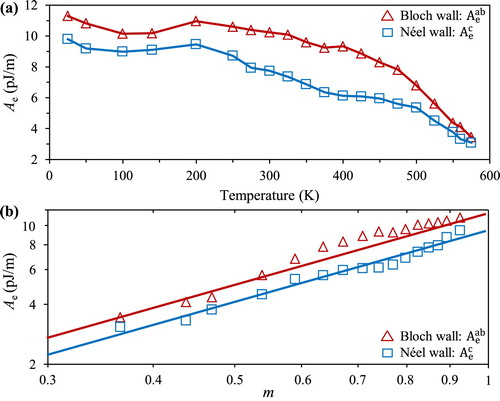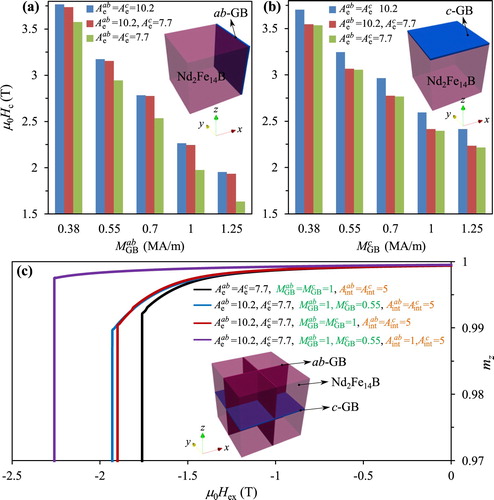Figures & data

Figure 1. ASM simulated temperature-dependent domain wall configurations displayed by the distribution of atomistic magnetic moments (easy axis tilted from z-axis with a angle ): (a) Bloch-like wall and (b) Néel-like wall. (c) The distribution of macroscopic magnetization component (
) along x axis in (a) and z axis in (b). (d) Domain wall width
at different temperatures.

Figure 2. Exchange stiffness (Ae) of Nd2Fe14B calculated by ASM simulation: Ae as a function of (a) temperature T and (b) normalized magnetization . The fitting lines in (b)
.

Figure 3. Interface exchange coupling strength () in Nd2Fe14B/GB evaluated by first-principles calculation. Unrelaxed and relaxed structure of Nd2Fe14B/FexNd1–x system with interface located at (a) (001) plane and (b) (100) plane. (c)
and (d) magnetization of FexNd1–x (
) as a function of Fe content x for both (001) and (100) interfaces. The experimental data in (d) are taken from the literature [Citation48–50].
![Figure 3. Interface exchange coupling strength (Jint) in Nd2Fe14B/GB evaluated by first-principles calculation. Unrelaxed and relaxed structure of Nd2Fe14B/FexNd1–x system with interface located at (a) (001) plane and (b) (100) plane. (c) Jint and (d) magnetization of FexNd1–x (MFeNd) as a function of Fe content x for both (001) and (100) interfaces. The experimental data in (d) are taken from the literature [Citation48–50].](/cms/asset/7c2e8682-d1fe-47a4-9868-981e71fcf248/tmrl_a_1702116_f0003_oc.jpg)
Figure 4. Dependency of coercivity on anisotropic exchange. Effect of anisotropic exchange stiffness of Nd2Fe14B (Ae) in single grain with GB at (a) a surface and (b) c surface (with the same pJ/m). (c) Effect of Ae, GB composition anisotropy, and anisotropic exchange coupling between two regions (
) in multigrain Nd–Fe–B. Ae and
: pJ/m.
: MA/m. Grain size: 100 nm. GB thickness: 4 nm. The external field is applied along negative z axis.

